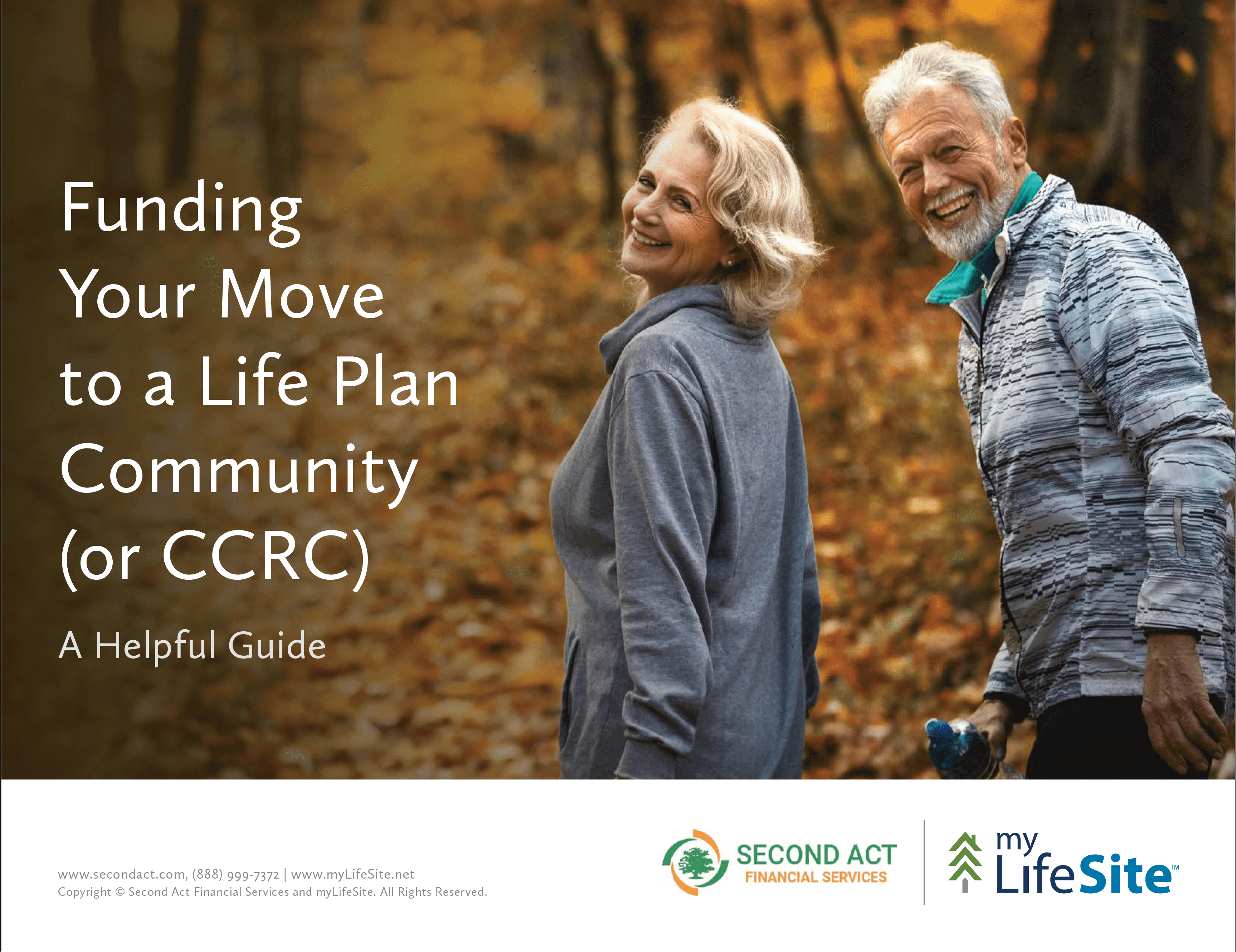As you plan for retirement, making informed choices about your living arrangements is more important than ever. Continuing Care Retirement Communities (CCRCs) and Life Plan Communities offer a range of services tailored to meet the needs of seniors at different stages of retirement. These communities support an active and secure lifestyle while providing care options that adapt as your needs change. When you choose a CCRC or Life Plan Community, you gain the flexibility to live independently with the assurance that higher levels of care are available if and when you need them as you age. This allows you to plan your future with confidence, knowing that your living situation can evolve with your health requirements.

What is a Life Plan Community or Continuing Care Retirement Community (CCRC)?
Life Plan Communities are sought after by those who want an active, engaging, vibrant retirement lifestyle, along with the peace of mind of having a full continuum of care available as needed. Most life plan communities offer a large campus-like setting providing housing, hospitality services, and amenities to independent and active seniors, along with care services that are available as needed, typically including assisted living, memory care and skilled nursing care.
Around three-quarters of all life plan communities require an entry fee, which may be partially to fully refundable to one’s estate, and possibly sooner if the resident vacates the unit. The other approximately 25% of life plan communities operate either on a rental-only basis or an equity (or co-op) ownership model whereby you own your home or a share of the community’s corporation, but still pay monthly fees for the available services.
The Three Main Types of Life Plan Communities and Continuing Care Retirement Communities (CCRCs)
Entrance Fee:
Fully, partially, or not refundable to your estate. Be sure to understand the contract stipulations and requirements for an entry fee refund. Some CCRCs may return to your estate up to 100% of your Entry Fee. Others may refund a declining balance. And yet others offer a partial refund based on a percentage of your original deposit. Usually these fees are refunded to your estate upon the unit selling to a new owner. So be sure to check the details and options in your contract!
Equity or Co-Op:
In this CCRC contract arrangement you own the title to your unit or have co-op ownership rights. Some equity-based life plan communities do not provide true ownership, but instead allow the resident or the resident’s heirs to share in the potential appreciation of the home or apartment when resold.
Rental:
No entry fee required other than possibly a nominal initial community fee upon moving into the community. Thereafter, a monthly service fee is charged for the chosen services provided to you.
The Four Main Types of CCRC and Life Plan Community Contracts:
The contract type that is best for you will depend on your personal financial circumstances, needs and preferences. Here is a general description of the main types of CCRC residency contracts:
Type A (lifecare) contract:
All other things being equal, a resident with a lifecare contract will pay more while living independently, either in the form of a higher entry fee or a higher monthly service fee. The trade-off is that almost all residential services, amenities, and if needed, health-related services — such as assisted living or skilled nursing care — are provided with little or no increase in monthly fees, other than inflationary adjustments and potential ancillary costs. The benefit of a lifecare contract is that it provides better predictability of expenses for the rest of one’s life, regardless of healthcare needs in the future. On the other hand, a resident with a lifecare contract is paying more at the front end for care services that may not be needed in the future.
Equalized Rate Lifecare:
A newer and increasingly common version of the lifecare contract is referred to in the industry as “equalized pricing.” With this type of pricing structure, when a resident makes a permanent transfer to assisted living or skilled nursing care, they do not necessarily continue to pay the same monthly rate they paid in independent living. Instead, they begin paying a pre-determined amount that is typically equal to the pricing for a specific residential unit. For instance, the pre-determined price may be equal to mid-priced independent living apartment. Therefore, a resident who was in a lower priced (typically smaller) residence would pay more for assisted living or skilled nursing care services, but someone who was in a higher priced residence (typically larger) would pay less. Thus, the term, “equalized pricing” — all residents pay the same rate for healthcare services.
Type B (modified):
Under a modified CCRC residency contract, the entry fee and/or monthly service fee will offset the cost for some amount of care needed in the future but not on an unlimited basis. For example, the cost of skilled nursing services may be offered at a 20–30% discount off the market rate. Alternatively, the contract may afford a certain number of days in the healthcare center at no additional cost before the resident begins paying the full per diem cost. These “free” days, as they are sometimes called, may be offered on a per-year basis or over the life of the contract.
Type C (fee-for-service):
All other things being equal, a fee-for-service contract will require a lower entry fee and/or monthly fee than the two previously described contract types. However, if assisted living or skilled nursing care is required, the resident’s monthly fee will increase to reflect the market rate for care. In contrast to a lifecare (Type A) contract, although CCRC residents with a fee-for-service contract have unlimited exposure to the potentially higher costs of long-term care expenses, they also only pay for services they need.
Closing thoughts
Today’s Life Plan Communities (also known as Continuing Care Retirement Communities or CCRCs) can enrich your life in many ways. Studies show that living home alone or feeling socially isolated presents a higher risk of heart disease or depression. Having a sense of community, of safety, and waking up every morning to a vibrant, active, meaningful life, can make a big difference in your quality of life. When considering a move to a CCRC or Life Plan Community, it’s important to evaluate the benefits. These communities are designed to offer a blend of independence with an active, vibrant lifestyle with meaningful social engagement along with, as you age if needed, supportive care that adjusts to your needs as they change over time. They promote a vibrant lifestyle with ample opportunities for social interaction, physical activity, and personal growth.
Living arrangements range from independent living units to full-time nursing care, providing seamless transitions that can adapt to your health requirements without the need to relocate. Financially, CCRCs and Life Plan Communities often offer predictable costs, which can help with long-term budgeting. Reflect on how these advantages align with your retirement goals. Choosing a community that fits your desires and needs will support a rewarding and secure retirement experience. Consider how this setup matches your personal and health priorities to make the most informed decision.
About Second Act Financial Services
At Second Act Financial Services, we specialize in navigating CCRC financing challenges. Our team brings extensive experience in retirement and banking solutions, focusing on home sale solutions, home equity lines of credit that can serve as bridge loan solutions, and connections to veteran benefits, long-term care insurance or life settlement resources. We help you understand your options for managing CCRC entry fees and provide support with our financial options every step of the way. Our proven track record in assisting clients with their retirement financing needs reflects our commitment to your financial well-being. Trust us to guide you with expertise as you plan for life in your chosen retirement community. For more information on how we can assist you, visit Second Act Financial Services.
Important Disclaimer
The information in this page is not meant to serve as financial, tax, or personal financial planning advice. No decisions should be made from reading the information on this page. Decisions should be made after careful analysis and consultation with your financial, tax, accounting, or other professional advisor licensed to provide retirement advice.
Second Act is a Division of Liberty Savings Bank, F.S.B. Member FDIC. Lending and loan services provided by Liberty Savings Bank, F.S.B. NMLS # 408905. Equal Housing Lender. All other services provided by Second Act Financial Services, LLC. This information is current as of 1/01/2024. Subject to credit and loan approval. Conditions and limitations apply. Information, rates and terms are subject to change without notice. © 2024 Second Act Financial Services, LLC. All Rights Reserved.





Recent Comments